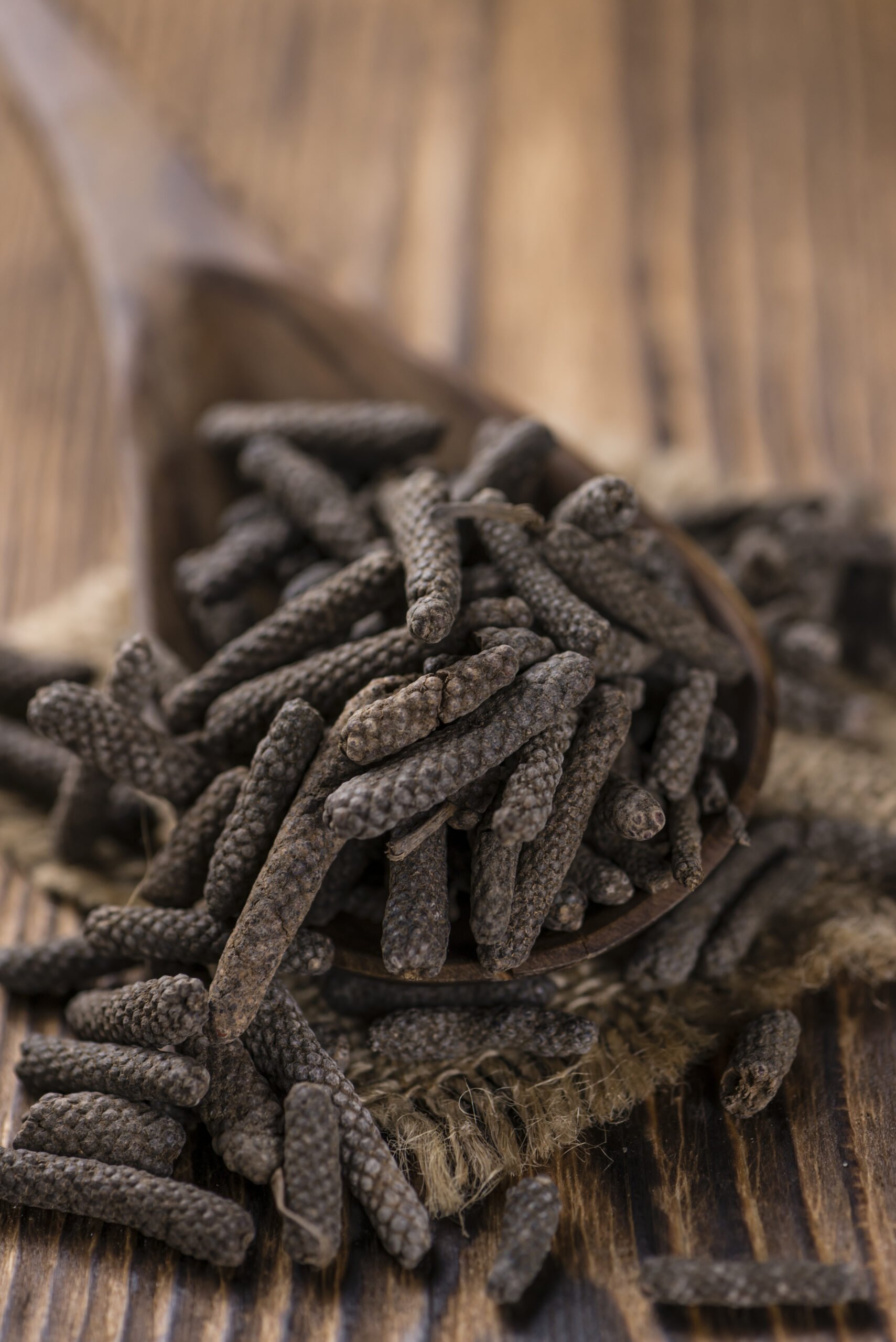
Long pepper, or Pippali, is one of the oldest recorded spices used in India. Before black pepper became widely traded, Pippali was common in everyday cooking and traditional remedies. It grows on a vine and is harvested when the small, clustered spikes mature and dry naturally. The spice was valued for both its warming flavor and its place in wellness practices.
In Ayurveda, long pepper is considered a heating spice that can support digestion and respiratory health. It is often used in herbal blends and tonics. Today, it appears in both traditional recipes and modern spice mixes, adding gentle heat and complexity where black pepper might be sharper or more direct.
What Is Long Pepper (Pippali)?
Long pepper (Piper longum) is a fruiting vine from the Piperaceae family, the same family as black pepper. Instead of round peppercorns, it produces small cylindrical spikes made of tightly packed pepper fruits. It is native to India and grows mainly in warm, tropical regions.
It has a deeper, slightly sweet heat compared to black pepper and is used in spice blends, pickles, and certain regional curries. Its combination of warmth and aroma makes it a versatile ingredient in both culinary and Ayurvedic settings.
Quick facts
- Name: Long pepper (Pippali)
- Scientific name: Piper longum
- Family: Piperaceae (same as black pepper)
- Native region: India and Southeast Asia
- Heat level: Warm, slightly sweet heat (milder than black pepper at first, then lingering)
- Main forms: Whole dried spikes or ground powder
- Used in: Curries, pickles, spice blends and Ayurvedic preparations
- Why use it: Adds warmth and depth with a distinctive aroma

The Drying and Processing Method
Once harvested, long pepper spikes are sorted, cleaned and dried in direct or indirect sunlight. Drying typically takes a few days, during which the color changes from green to a dark brown-black shade. This slow drying step helps concentrate natural oils and preserves the characteristic warming flavor.
Some commercial processors use controlled drying to maintain uniform quality, but sun-drying is still common. After drying, the spikes are packed and stored whole or ground into powder for use in cooking and traditional preparations.
Forms You’ll Find It In
Long pepper is available in different forms depending on how it will be used:
-
Whole spikes: Added to teas, soups and spice infusions to provide gentle heat
-
Ground powder: Used in spice mixes, pickles and seasoned masalas
-
Herbal extracts or oils: Included in traditional remedies and topical preparations
-
Capsules or supplements: Used in modern Ayurvedic formulations
Each form offers the same core flavor profile, with the whole spice typically giving the slowest and softest release of heat.
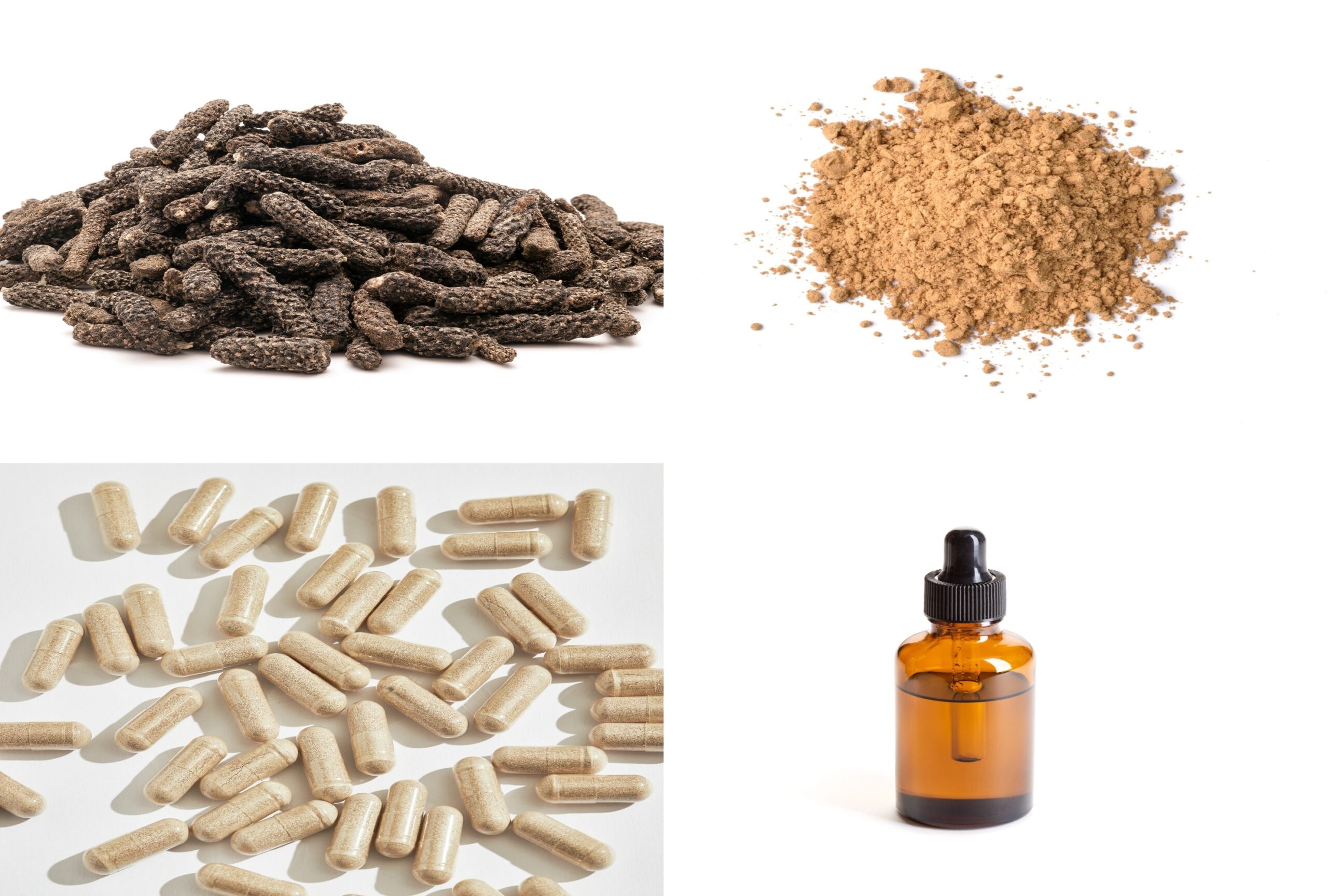
Flavor Profile
Long pepper has a warm, lingering heat that develops more gradually than black pepper. The flavor is deeper and slightly sweeter, with light woody and earthy notes. It provides warmth without the sharp bite of regular pepper, which makes it suitable for dishes where a slower, rounded heat is preferred.
Culinary Uses Around the World
-
India: Used in certain regional curries, rasam, pickles and in traditional drinks or tonics. It appears most often in Ayurvedic recipes rather than everyday home cooking.
-
Indonesia & Malaysia: Included in some spice pastes, satay marinades and sambal-style condiments for added warmth and aroma.
-
Nepal & Tibet: Added to herbal teas, broths and winter dishes for a gentle heating effect.
-
Historic Europe: Common in medieval European cooking before black pepper became widely available, used in sauces, stews and preserved foods.
-
Modern Cuisine: Occasionally used by chefs for its complex heat in marinades, spice rubs and some desserts or drinks.
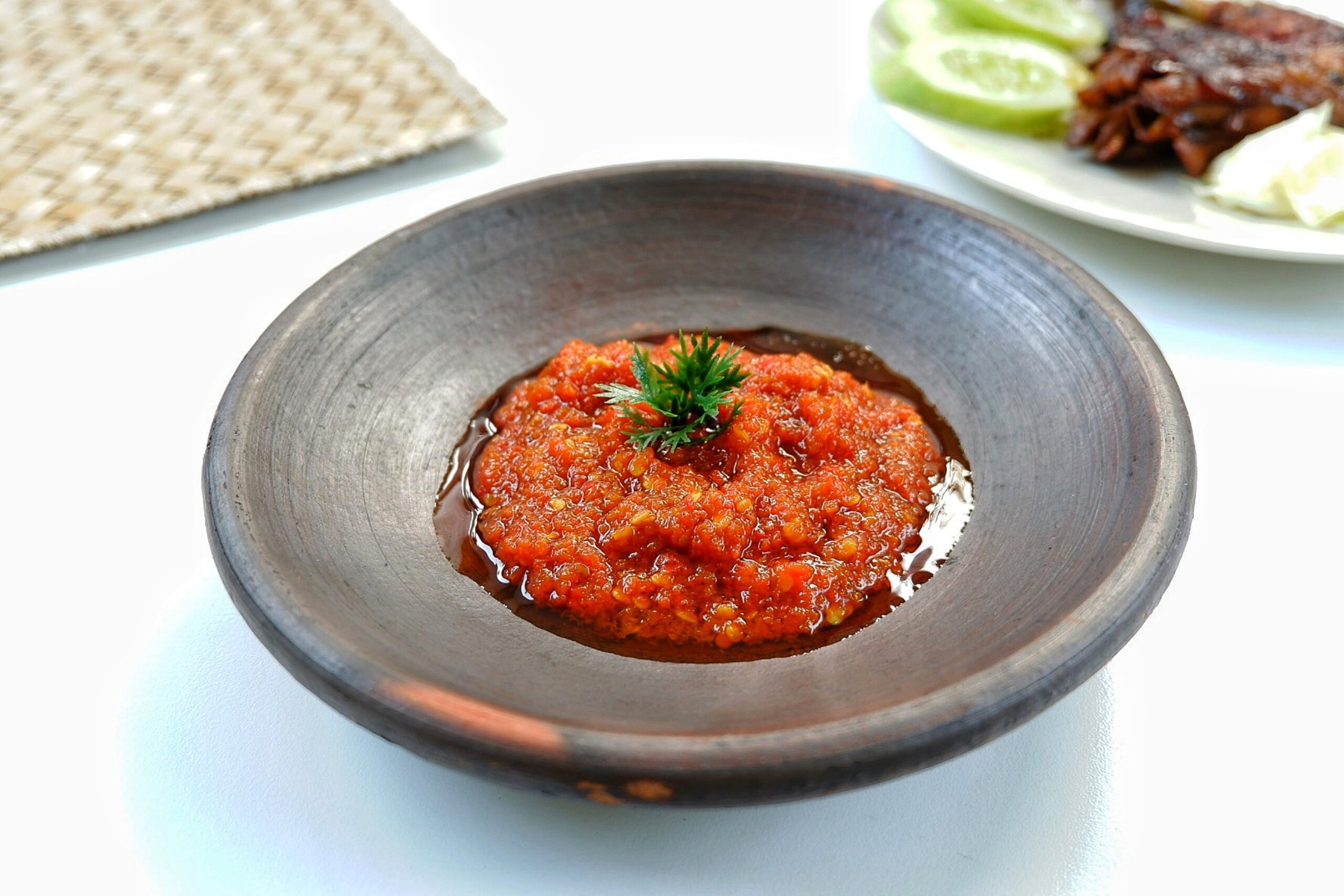

Creative Ways to Use Long Pepper
Pippali may be ancient, but it fits beautifully into today’s kitchen. Try these simple, creative ways to enjoy its warmth:
-
Crush lightly into chai or hot chocolate for a mellow, spicy twist.
-
Mix with honey to drizzle over pancakes or yogurt.
-
Add to roasted vegetables or lentil soups for earthy complexity.
-
Blend into ghee or butter for spreading on toast or naan.
-
Infuse in olive oil or vinegar to create aromatic dressings.
Flavor Pairings
Pippali pairs beautifully with both warm spices and sweet ingredients, blending depth with balance.
-
Spice companions: Cardamom, cinnamon, clove, nutmeg, and ginger.
-
Sweet notes: Jaggery, honey, dates, or coconut sugar.
-
Savory matches: Lentils, mushrooms, slow-cooked meats, and root vegetables.
-
Liquid pairings: Milk, ghee, coconut milk, and even black tea.
Quick Tips to Get the Best Out of Long Pepper
A few small changes can help you bring Pippali’s old charm into modern cooking:
-
Crush, don’t grind: Breaking it coarsely keeps its natural oils intact.
-
Add late: Stir it in near the end of cooking to preserve aroma.
-
Toast gently: Light roasting releases warmth and sweetness.
-
Pair with ghee or honey: Helps absorb its active compounds better.
-
Use sparingly: A little goes a long way, its flavor builds slowly and stays.
Temple Remedies and Ayurvedic Traditions
In ancient India, long pepper was valued in both temple medicine and Ayurveda. Monks and healers used it in oils, tonics, and teas to boost strength, clear the lungs, and improve focus.
Its warmth was believed to bring balance to the body and mind. Over time, these temple practices inspired the home remedies people still use today.
Long Pepper in Home Remedies
For centuries, long pepper has been a trusted part of traditional healing at home. Its warm, stimulating nature makes it a common ingredient in simple remedies:
-
For cough and cold: Mixed with honey or warm milk to soothe the throat and ease congestion.
-
For digestion: Taken with ghee or a pinch of rock salt to relieve bloating and support appetite.
-
For fatigue: Added to herbal teas or tonics to restore energy and circulation.
-
For detox: Combined with turmeric and ginger in herbal mixtures to cleanse and strengthen the body.
Substitutes
If you can’t find Pippali, a few close substitutes can bring similar warmth and aroma to your dishes.
-
Black pepper: The most common alternative, milder but still pungent.
-
Cubeb pepper: Slightly bitter with a woody aroma, used in Indonesian cooking.
-
Indonesian long pepper: Hotter and spicier than Indian Pippali.
-
Balinese long pepper: Offers a sharper, citrusy note.
Each region gives its long pepper a distinct flavor from India’s earthy sweetness to Indonesia’s bold fire.
Nutritional Value (Per Teaspoon – Approx. 2g)
-
Calories: 6 kcal
-
Carbohydrates: 1.1 g
-
Protein: 0.2 g
-
Fat: 0.1 g
-
Fiber: 0.3 g
-
Vitamin C: Trace amounts
-
Active compound: Piperine contributes to its heat and potential health benefits
While used sparingly, long pepper adds more than flavor, it contributes gentle stimulation and natural plant energy to food and tonics.
Health Benefits
-
Supports digestion: May stimulate digestive enzymes and ease bloating (Source).
-
Boosts metabolism: Can promote better nutrient absorption when paired with turmeric or ghee (Source).
-
Aids respiratory health: May help relieve congestion and soothe sore throats (Source).
-
Anti-inflammatory effects: Can help reduce oxidative stress in the body (Source).
-
Promotes circulation: May help improve circulation and energy (Source 1, 2).
Used thoughtfully, Pippali can bring both warmth and wellness to everyday life.
Potential Health Risks
Pippali is generally safe when used in small amounts but overuse may lead to discomfort.
-
Digestive sensitivity: Excess use can irritate the stomach or cause acidity (Source).
-
Heat in the body: It may increase internal warmth, especially in hot climates (Source).
-
Allergic reactions: Rare but possible in those sensitive to peppers (Source).
-
High doses: Can interact with certain medications or cause mild irritation (Source).
How to Store It Right
Proper storage helps Pippali retain its aroma and potency for months.
-
Use airtight glass jars: Prevents moisture and odor absorption.
-
Keep away from sunlight: Direct heat can fade its color and reduce flavor strength.
-
Store in a cool, dry cupboard: Avoid humidity and temperature swings.
-
Grind in small batches: Whole spikes stay fresh longer than powdered form.
-
Shelf life: Can stay fragrant for up to 10–12 months if stored correctly.
Final Thoughts
Long pepper remains a useful spice in both cooking and traditional wellness practices. Its slow, warming heat and deeper flavor make it a practical alternative to black pepper in certain preparations. Although it is not as common in everyday Indian kitchens today, it continues to be used in regional recipes, Ayurvedic blends and modern dishes that look for added complexity.
As interest in traditional ingredients grows, long pepper is finding new relevance while still maintaining its original purpose: adding steady warmth and distinct flavor wherever it is used.
FAQs
Is long pepper the same as black pepper?
No, long pepper comes from a related vine but has a different shape and a deeper, slower-building heat.
What is Pippali used for in Ayurveda?
It may support digestion, boost metabolism, and help clear congestion when used moderately in teas or tonics.
Can I use long pepper in place of black pepper?
Yes, but use smaller amounts, its flavor is stronger and more complex.
How should long pepper be stored?
Keep it in airtight jars away from sunlight and moisture to preserve its aroma and potency.
Where can I buy long pepper?
You can find it in Indian spice markets, Ayurvedic shops, or online under names like “Pippali” or “Indian long pepper.”
Is long pepper safe for daily use?
Yes, in small quantities. However, excessive intake may cause acidity or irritation in sensitive individuals.
Learn More About Long Pepper (Pippali)
Wikipedia — Long Pepper
A brief article on long pepper (Pippali) covering its traditional Ayurvedic and temple uses, key health benefits like aiding digestion and improving circulation, and precautions such as avoiding excess use due to its warming nature.
Zingerman's Deli — The Loveliness of Long Pepper
This article is tracing long pepper’s Indian origins, historic value in ancient Rome, and modern rediscovery for its sweet, smoky flavor used in both savory and sweet dishes.


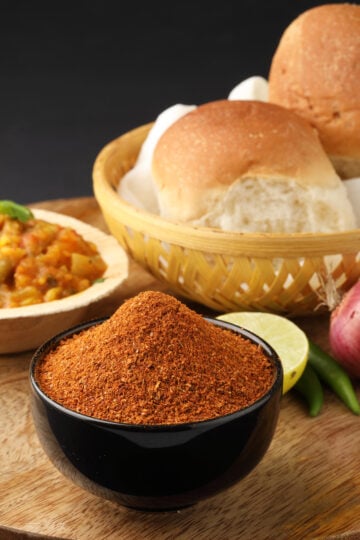
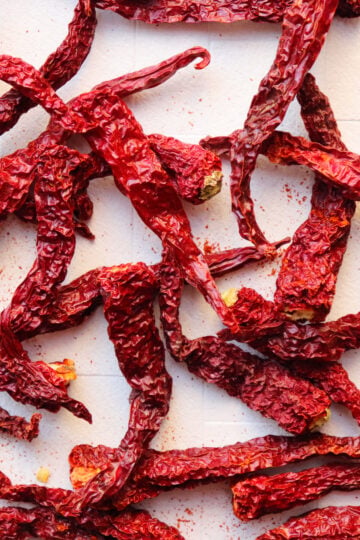
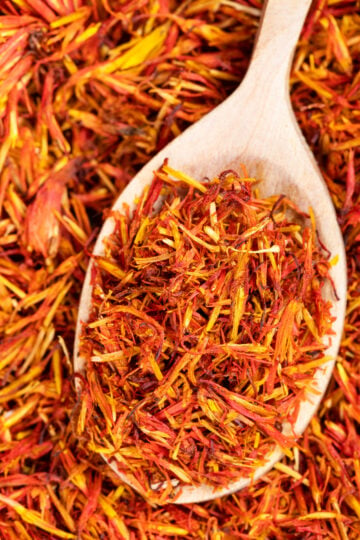
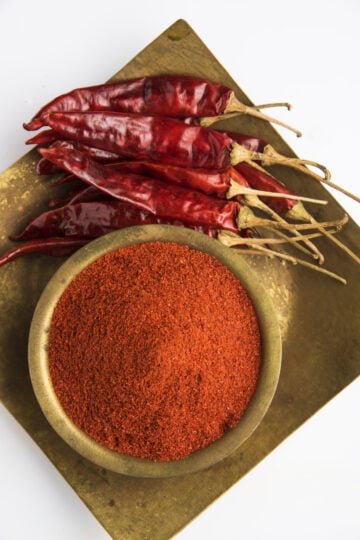
Have a question or something to share? Leave a comment below!